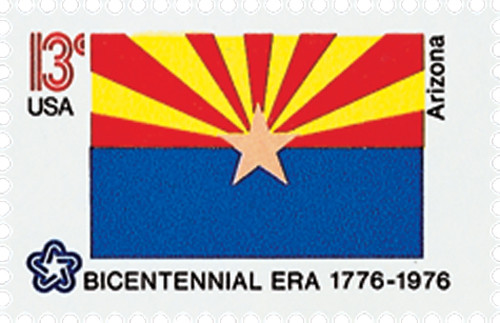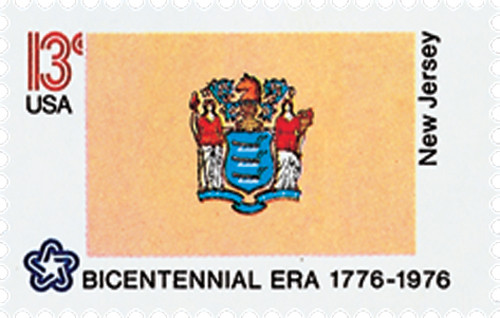
# 1680 - 1976 13c State Flags: Arizona
U.S. 1680
1976 Arizona
State Flags
American Bicentennial Series
• First time a sheet 50 had all different stamp designs
• Part of the American Bicentennial Series
Stamp Category: Commemorative
Series: American Bicentennial Series
Value: 13¢ First-class postage rate
First Day of Issue: February 23, 1976
First Day City(s): Washington, DC
Quantity Issued: 8,720,100 (panes of 50)
Printed by: Bureau of Engraving and Printing
Printing Method: Photogravure
Format: Sheet of 50
Perforations: 11
Why the stamp was issued:
The United States Postal Service celebrated the American Bicentennial with a full pane of the Union’s fifty state flags.
About the stamp design:
The Arizona State Flag is based on an original design created for the Arizona National Guard Rifle Team in 1910. Colonel Charles Wilfred Harris worked with Carl Hayden, Arizona’s first representative in Congress, to create a banner that reflected Arizona’s history and values. Arizona achieved statehood on February 14, 1912. Colonel Harris, who was appointed as the Adjutant General of Arizona, used the rifle team flag as the model for the new state’s flag. The top half of the flag symbolizes the original 13 American colonies and the western setting sun. The copper star signifies Arizona’s status as the largest copper-producing state in the U.S. The red and yellow colors found in the rays of the setting sun represent the colors flown by Francisco Vasquez de Coronado and the Spanish Conquistadors.
About the printing process:
Printed by the Bureau of Engraving and Printing on their seven-color Andreotti gravure press (601) which was their work horse for multicolored stamps.
About the American Bicentennial Series:
In the 1970s, America celebrated its 200th anniversary with hundreds of national events commemorating the heroes and historic events that led to our nation’s independence from Great Britain. The U.S. Postal Service issued 113 commemorative stamps over a six-year period in honor of the U.S. bicentennial, beginning with the American Revolution Bicentennial Commission Emblem stamp (U.S. #1432). As a group, the Bicentennial Series chronicles one of our nation’s most important chapters, and remembers the events and patriots who made the U.S. a world model for liberty.
Several of the stamps honored colonial life – craftsmen and communication. Other stamps honored important battles including Lexington and Concord, Bunker Hill, and Saratoga. Significant events such as the Boston Tea Party, the meeting of the First Continental Congress, and the Declaration of Independence were featured as well. The stamps also honored many significant people such as George Washington, Sybil Ludington, Salem Poor, and the Marquis de Lafayette.
Many of the stamps feature classic artwork. For instance, the set of four souvenir sheets picture important events recreated by noted artists such as John Trumbull. The Bicentennial Series also includes an important US postal first – the first 50-stamp se-tenant – featuring all 50 state flags. The format proved to be popular with collectors, and has been repeated many times since.
The American Bicentennial Series is packed with important US history – it tells the story of our nation’s fight for independence through stamps.
History the stamp represents:
Arizona achieved statehood on February 14, 1912.
Arizona was once home to the Anasazi – the ancestors of the Pueblo Indians. Stories of the Seven Cities of Cibola – said to contain great amounts of wealth – sent many Spanish explorers on futile quests into the region. A Franciscan priest, Marcos de Niza, was the first white person known to reach Arizona in 1539.
In 1752, the Spanish established the first white settlement at Tubac. When Mexico won its independence from Spain in 1821, Arizona became part of Mexico. The area changed hands again after the Mexican-American War, when most of Arizona became part of the U.S. Arizona settlers unsuccessfully attempted to become a distinct U.S. territory in the 1850s. Many settlers were from the South, and were sympathetic to the Confederacy when it was formed in 1861. When the Confederate government created the Confederate Territory of Arizona, it was largely a symbolic gesture.
U.S. Congress created the Arizona Territory in 1863, with roughly the same boundaries as the modern state. Despite the dangers presented by hostile Indians, Arizona grew in the years following the war. The territory’s economic growth was fueled by discoveries of gold and silver. Ingenuity also aided Arizona. Farmers began irrigating their fields as early as 1867. During the 1870s and ’80s, copper mines were developed. On September 30, 1877, the Southern Pacific Railroad connected Arizona to California, further enhancing the territory’s growth.
Around 1890, well-organized groups began to lobby Congress in an effort to achieve statehood. However, Congress refused to act for 20 years. In 1910, Arizona was allowed to create a state constitution and apply for statehood. This was done, but President William Howard Taft vetoed the bill that would have granted statehood. Taft was concerned the state constitution allowed for recall – a process through which voters could remove judges from office. Once this clause was taken out of the constitution, statehood was approved. Arizona finally achieved statehood on February 14, 1912. Soon after, the people amended their constitution to allow recall of judges.
U.S. 1680
1976 Arizona
State Flags
American Bicentennial Series
• First time a sheet 50 had all different stamp designs
• Part of the American Bicentennial Series
Stamp Category: Commemorative
Series: American Bicentennial Series
Value: 13¢ First-class postage rate
First Day of Issue: February 23, 1976
First Day City(s): Washington, DC
Quantity Issued: 8,720,100 (panes of 50)
Printed by: Bureau of Engraving and Printing
Printing Method: Photogravure
Format: Sheet of 50
Perforations: 11
Why the stamp was issued:
The United States Postal Service celebrated the American Bicentennial with a full pane of the Union’s fifty state flags.
About the stamp design:
The Arizona State Flag is based on an original design created for the Arizona National Guard Rifle Team in 1910. Colonel Charles Wilfred Harris worked with Carl Hayden, Arizona’s first representative in Congress, to create a banner that reflected Arizona’s history and values. Arizona achieved statehood on February 14, 1912. Colonel Harris, who was appointed as the Adjutant General of Arizona, used the rifle team flag as the model for the new state’s flag. The top half of the flag symbolizes the original 13 American colonies and the western setting sun. The copper star signifies Arizona’s status as the largest copper-producing state in the U.S. The red and yellow colors found in the rays of the setting sun represent the colors flown by Francisco Vasquez de Coronado and the Spanish Conquistadors.
About the printing process:
Printed by the Bureau of Engraving and Printing on their seven-color Andreotti gravure press (601) which was their work horse for multicolored stamps.
About the American Bicentennial Series:
In the 1970s, America celebrated its 200th anniversary with hundreds of national events commemorating the heroes and historic events that led to our nation’s independence from Great Britain. The U.S. Postal Service issued 113 commemorative stamps over a six-year period in honor of the U.S. bicentennial, beginning with the American Revolution Bicentennial Commission Emblem stamp (U.S. #1432). As a group, the Bicentennial Series chronicles one of our nation’s most important chapters, and remembers the events and patriots who made the U.S. a world model for liberty.
Several of the stamps honored colonial life – craftsmen and communication. Other stamps honored important battles including Lexington and Concord, Bunker Hill, and Saratoga. Significant events such as the Boston Tea Party, the meeting of the First Continental Congress, and the Declaration of Independence were featured as well. The stamps also honored many significant people such as George Washington, Sybil Ludington, Salem Poor, and the Marquis de Lafayette.
Many of the stamps feature classic artwork. For instance, the set of four souvenir sheets picture important events recreated by noted artists such as John Trumbull. The Bicentennial Series also includes an important US postal first – the first 50-stamp se-tenant – featuring all 50 state flags. The format proved to be popular with collectors, and has been repeated many times since.
The American Bicentennial Series is packed with important US history – it tells the story of our nation’s fight for independence through stamps.
History the stamp represents:
Arizona achieved statehood on February 14, 1912.
Arizona was once home to the Anasazi – the ancestors of the Pueblo Indians. Stories of the Seven Cities of Cibola – said to contain great amounts of wealth – sent many Spanish explorers on futile quests into the region. A Franciscan priest, Marcos de Niza, was the first white person known to reach Arizona in 1539.
In 1752, the Spanish established the first white settlement at Tubac. When Mexico won its independence from Spain in 1821, Arizona became part of Mexico. The area changed hands again after the Mexican-American War, when most of Arizona became part of the U.S. Arizona settlers unsuccessfully attempted to become a distinct U.S. territory in the 1850s. Many settlers were from the South, and were sympathetic to the Confederacy when it was formed in 1861. When the Confederate government created the Confederate Territory of Arizona, it was largely a symbolic gesture.
U.S. Congress created the Arizona Territory in 1863, with roughly the same boundaries as the modern state. Despite the dangers presented by hostile Indians, Arizona grew in the years following the war. The territory’s economic growth was fueled by discoveries of gold and silver. Ingenuity also aided Arizona. Farmers began irrigating their fields as early as 1867. During the 1870s and ’80s, copper mines were developed. On September 30, 1877, the Southern Pacific Railroad connected Arizona to California, further enhancing the territory’s growth.
Around 1890, well-organized groups began to lobby Congress in an effort to achieve statehood. However, Congress refused to act for 20 years. In 1910, Arizona was allowed to create a state constitution and apply for statehood. This was done, but President William Howard Taft vetoed the bill that would have granted statehood. Taft was concerned the state constitution allowed for recall – a process through which voters could remove judges from office. Once this clause was taken out of the constitution, statehood was approved. Arizona finally achieved statehood on February 14, 1912. Soon after, the people amended their constitution to allow recall of judges.


















